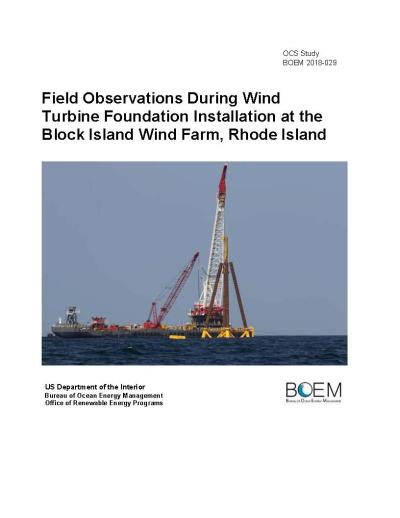- Appendix A; Field Plan
- Appendix C; Airborne Noise Monitoring
- Appendix D; Underwater Sound Monitoring
- Appendix E1; Seafloor Disturbance and Recovery
- Appendix E2; Seafloor Disturbance and Recovery
- Appendix E3; Seafloor Disturbance and Recovery
- Appendix F; Scour Monitoring Data
Title: Field Observations during Wind Turbine Foundation Installation at the Block Island Wind Farm, Rhode Island
Key Researchers: J. Amaral, R. Beard, R. Barham, A. Collett, J. Elliot, A. Frankel, D. Gallien, C. Hager, A. Khan, Y-T. Lin, T. Mason, J. Miller, A. Newhall, G. Potty, K. Smith, and K. Vigness-Raposa
With the first offshore wind facilities being built along the Atlantic coast, there is the opportunity to make direct, real-time measurements of the nature, intensity, and duration of potential stressors during the construction and initial operations of selected proposed offshore wind facilities. The first facility to be constructed is the Block Island Wind Farm (BIWF), off the coast of Rhode Island. Monitoring was conducted at BIWF during the installation of the wind turbine foundations in the summer and fall of 2015 and includes: visual monitoring of construction activities from onshore and offshore locations; onshore and offshore airborne noise monitoring; near- and far-field underwater sound monitoring; seafloor disturbance and recovery monitoring; and turbine foundation scour monitoring.
Findings
- Airborne noise monitoring data analyses indicated that the noise from the pile driving was clearly audible at the Southeast Lighthouse (3 mi), but was not detected at Point Judith (17 mi) on the mainland
- Results from preliminary data analyses show that pile driving sound was above background sound levels at ranges in excess of 20 km (12.4 mi)
- Seafloor disturbance from anchoring and lift boat legs recovers observably within months and recovery rates generally correspond to seabed mobility
- Testing of scour monitors provided a long-term time series (16 mos) of seabed elevations near the foundation that showed minor scour around the observed legs
How BOEM will use this information
- Provide information for BOEM’s evaluation of environmental effects of future facilities
- Provide data to improve the accuracy of models and analysis criteria to establish mitigation and monitoring requirements


